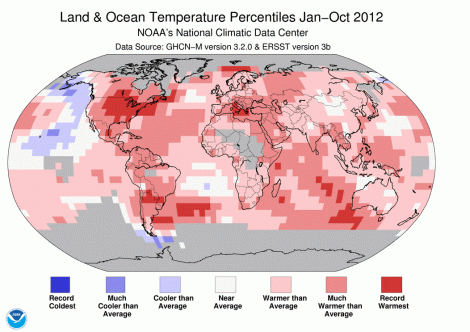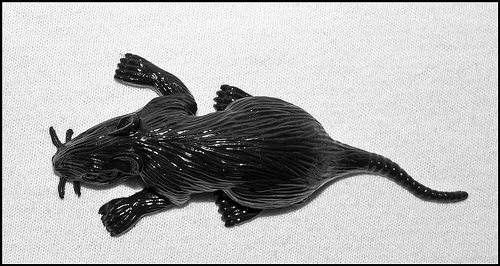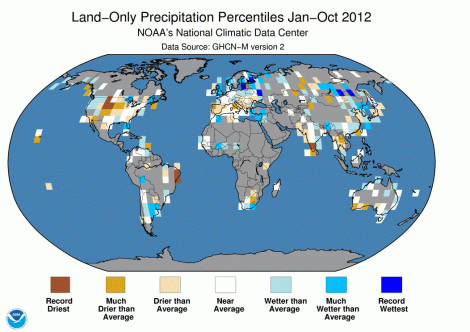This image sums up 2012, temperature-wise.

NOAAClick to embiggen.
Nowhere on the surface of the planet have we seen any record cold temperatures over the course of the year so far. Every land surface in the world saw warmer-than-average temperatures except Alaska and the eastern tip of Russia. The continental United States has been blanketed with record warmth — and the seas just off the East Coast have been much warmer than average, for which Sandy sends her thanks.
The National Oceanic and Atmospheric Administration summarizes October 2012:
The average temperature across land and ocean surfaces during October was 14.63°C (58.23°F). This is 0.63°C (1.13°F) above the 20th century average and ties with 2008 as the fifth warmest October on record. The record warmest October occurred in 2003 and the record coldest October occurred in 1912. This is the 332nd consecutive month with an above-average temperature.
Emphasis added. If you were born in or after April 1985, if you are right now 27 years old or younger, you have never lived through a month that was colder than average. That’s beyond astonishing.
The year has also been remarkably dry, particularly in the United States.
And as Weather Underground’s Jeff Masters notes, that means drought — which can be far more damaging than a superstorm.
[S]hockingly, Sandy is probably not even the deadliest or most expensive weather disaster this year in the United States — Sandy’s damages of perhaps $50 billion will likely be overshadowed by the huge costs of the great drought of 2012. While it will be several months before the costs of America’s worst drought since 1954 are known, the 2012 drought is expected to cut America’s GDP by 0.5 – 1 percentage points, said Deutsche Bank Securities this week. …
While Sandy’s death toll of 113 in the U.S. is the second highest death toll from a U.S. hurricane since 1972, it is likely to be exceeded by the death toll from the heat waves that accompanied this year’s drought. The heat waves associated with the U.S. droughts of 1980 and 1988 had death tolls of 10,000 and 7,500 respectively, according to NOAA’s National Climatic Data Center, and the heat wave associated with the $12 billion 2011 Texas drought killed 95 Americans.
There’s not much else to say. At this point, we’re just doctors taking a fading pulse. Or, I suppose, tracking a rising fever.





